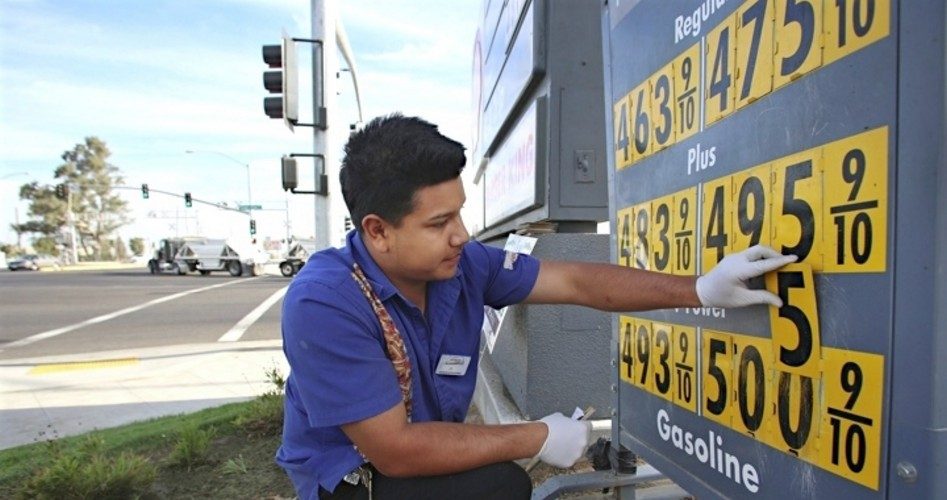
Gasoline prices in California have escalated to record highs, spiking 50 cents a gallon in a week and prompting Governor Jerry Brown to advocate laxer smog rules so oil refineries can boost supplies of less expensive fuel blends. Regular gasoline in the state has soared to an average of $4.67 a gallon, a staggering 22 percent higher than the national average, according to AAA’s nationwide fuel price survey.
The average price of gas in California lingered at $4.17 a gallon on October 1, but has boosted every day since, with the worst increase being a 17-cent hike on Friday — placing it over $1 a gallon higher than in a dozen other states. Many gas stations are displaying prices seen nowhere else in the country, including those in the Big Sur area featuring prices as high as $5.89 a gallon.
With the gas crisis has come widespread cases of criminal activity, as police departments scramble to catch thieves who steal fuel from gas stations and other business, such as car and truck rental agencies. In Roseville, a town in metro Sacramento, thieves targeted two stations, peeling out with nearly 1,000 gallons of the increasingly expensive fuel.
James Hamilton of Econbrowser asserts that the turbulent rise in gas prices is prompted largely by two culprits, a lack of pipeline capacity and the state’s overly burdensome standards on air quality:
The Chevron refinery in Richmond (across the bay from San Francisco) has a normal capacity of 243,000 barrels per day, or 8.5% of the total petroleum products supplied to Petroleum Administration for Defense District 5, of which California is a part. But a fire at the Richmond refinery in August has significantly reduced its production.
The Kettleman-Los Medanos pipeline, which carries 85,000 barrels per day of crude oil to the San Francisco Bay Area, has been closed since mid-September due to organic chloride contamination. And on Monday, a power outage shut down ExxonMobil’s 149,000-barrel-per-day Torrance refinery in L.A.
Two factors allow the price in California to spike much higher than the rest of the country. First, a different blend is required to meet California air quality standards. Second, there is little pipeline capacity to bring in refined product from elsewhere.
But in addition to the strict, California-specific gasoline blend, which has contributed to widespread shortages, the state’s astronomical gas taxes also play an integral role in the state’s increasing fuel burden. California gas taxes are significantly higher than the national average, even as much as 40-cents-per-gallon higher than in some states. And Gregg Laskoski, a senior petroleum analyst for GasBuddy.com, says California’s budgetary woes could boost the state’s already staggeringly high gas tax even higher:
California’s combined federal, state, and local gasoline tax is among the highest in the United States at 67 cents per gallon. Only Connecticut (71 cents per gallon) and New York (67.4 cents per gallon) are higher. Nonetheless, Californians could soon see those taxes increase. The state’s budget deficit, estimated by Gov. Jerry Brown at $9 billion in January, was off by just a smidge ($7 billion). Now facing a $16 billion deficit, Brown said he plans to raise the state sales tax (the highest in the United States) from 7.25 percent to 7.5 percent and, of course, he’s looking beyond that, too.
Consequently, California environmental regulators conceded to a request from Gov. Jerry Brown to permit oil refineries to start manufacturing a cheaper “winter blend” of gasoline, which could allay shortages of the more expensive “summer blend” that helped ignite the mounting price hike. In most states, refineries transition from the cleaner summer blends to the winter blends in mid-September, but in California, typically the winter blend is not sold until the end of October, due to the state’s warmer average temperatures and its heavy regulations on air pollution.
“Gas prices in California have risen to their highest levels ever, with unacceptable cost impacts on consumers and small businesses,” Brown affirmed Sunday in a statement. “I am directing the Air Resources Board to immediately take whatever steps are necessary to allow an early transition to winter-blend gasoline.”
Some critics denounce the political defense that arbitrary supply gaps are the sole provocateur of California’s unprecedented gas crisis. The Wall Street Journal, for example, scrutinized state officials for blaming the crisis solely on disruptions in the supply chain, adding that Californians are “paying through the nozzle for their greener-than-thou government.” The publication details:
This gas crisis is self-inflicted, like so many problems in the state. Because California’s fuel regulations are the most stringent in the country, the state is isolated from other energy markets. Few refineries in the world can produce the unique reformulated gasoline blend that the state requires, and almost all are located in California.
The WSJ adds that the enormous cost of the state’s toxic business environment, “which is baked into everything Californians consume,” is one more reason that businesses — and consequently, jobs — are fleeing to other states. Meanwhile, Environmental Protection Agency head Lisa Jackson, in a rather unfortunately-timed announcement, has hailed California as her environmental archetype for the nation.
Photo: Luis Cuevas changes the gas prices at the Shell station off California State Route 99 as truckers deal with rising gas prices in Fresno, Calif., Oct. 5, 2012: AP Images



